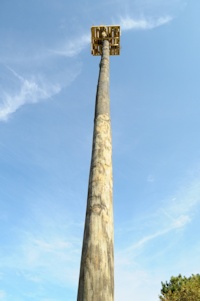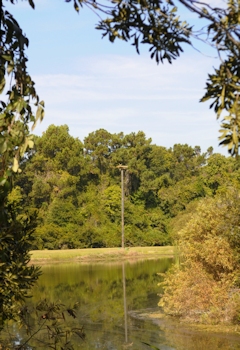Oct '1311
 The Johns Island Conservancy and Berkeley Electric Cooperative have successfully installed two Osprey platforms at Mullet Hall County Park and Legare Farms. The simple, easy to build platforms were based on a design provided by the The Center for Birds of Prey in Awendaw.
The Johns Island Conservancy and Berkeley Electric Cooperative have successfully installed two Osprey platforms at Mullet Hall County Park and Legare Farms. The simple, easy to build platforms were based on a design provided by the The Center for Birds of Prey in Awendaw.
 Osprey and eagles are unique among our South Carolina birds for their diet of live fish and remarkable ability to dive into the water with feet outstretched to catch them. These birds are also notable for having rebounded in numbers since the ban of the pesticide DDT. For the most part, they coexist well with human beings.
Ospreys prefer to nest in tall trees with unobstructed views of the surrounding sky to protect themselves from predators. They also need to be relatively close to water and their food source. Like human beings, one of the biggest struggles in an Osprey’s life is finding a good place to raise a family. Suitable trees can be hard to come by. Recycled telephone poles and flat platforms, make excellent sites the birds can return to season after season.
Human development along the coastline has reduced the number of natural nesting sites available, which is why many Osprey turn to an artificial site when looking for a home. In fact, artificial nesting sites have played a vital role in the “comeback†of the Osprey. The Osprey’s ability to adapt to artificial sites, and humans, has helped bring this bird back from near extinction, before the ban of DDT. Ospreys are extremely loyal to their nesting sites, so once an Osprey pair adopts a platform, there is a good chance they will return each nesting season.
Our Johns Island sites are selected based on two main criteria; first, suitability for Osprey nests and secondly, accessibility for public viewing from a proper distance. This provides an educational and recreational opportunity for the public to observe Ospreys.
Our Johns Island platforms were assembled by Conservancy volunteers under the direction of Guy Leonard, the project manager. Berkeley Electric donated the “green†poles and did the “heavy liftingâ€, delivering them to each site. Next the platforms were attached to the poles on the ground and “furnished” with some starter twigs, moss and grasses. The Berkeley crew then returned, drilled a large hole into the ground, lifted the Osprey’s new home into the air and secured it. The platform nests are now ready for a happy couple to complete their “home decoration” for the 2014 nesting season which starts early next year.
The platform at the Charleston County Parks Mullet Hall Equestrian Center is located on the far side of a 1.2 acre pond that is easily viewed from the Equestrian Center. Ospreys have been observed fishing in the pond over the last couple of years.
The Legare Farms site is on a creek and close by the Stono River. Ospreys are already nesting on a nearby cell phone tower. Hopefully, this platform will attract them away from the tower where they might be in danger. The platform can be seen from the Farm’s pumpkin patch and picnic grounds.
Another platform is planned for the Charleston Area Therapeutic Riding Farm along River Rd. before the nesting season begins early next year. If you have a suitable property for an Osprey nesting platform or know of a property owners association or business that would like to sponsor one, please contact us.
Osprey and eagles are unique among our South Carolina birds for their diet of live fish and remarkable ability to dive into the water with feet outstretched to catch them. These birds are also notable for having rebounded in numbers since the ban of the pesticide DDT. For the most part, they coexist well with human beings.
Ospreys prefer to nest in tall trees with unobstructed views of the surrounding sky to protect themselves from predators. They also need to be relatively close to water and their food source. Like human beings, one of the biggest struggles in an Osprey’s life is finding a good place to raise a family. Suitable trees can be hard to come by. Recycled telephone poles and flat platforms, make excellent sites the birds can return to season after season.
Human development along the coastline has reduced the number of natural nesting sites available, which is why many Osprey turn to an artificial site when looking for a home. In fact, artificial nesting sites have played a vital role in the “comeback†of the Osprey. The Osprey’s ability to adapt to artificial sites, and humans, has helped bring this bird back from near extinction, before the ban of DDT. Ospreys are extremely loyal to their nesting sites, so once an Osprey pair adopts a platform, there is a good chance they will return each nesting season.
Our Johns Island sites are selected based on two main criteria; first, suitability for Osprey nests and secondly, accessibility for public viewing from a proper distance. This provides an educational and recreational opportunity for the public to observe Ospreys.
Our Johns Island platforms were assembled by Conservancy volunteers under the direction of Guy Leonard, the project manager. Berkeley Electric donated the “green†poles and did the “heavy liftingâ€, delivering them to each site. Next the platforms were attached to the poles on the ground and “furnished” with some starter twigs, moss and grasses. The Berkeley crew then returned, drilled a large hole into the ground, lifted the Osprey’s new home into the air and secured it. The platform nests are now ready for a happy couple to complete their “home decoration” for the 2014 nesting season which starts early next year.
The platform at the Charleston County Parks Mullet Hall Equestrian Center is located on the far side of a 1.2 acre pond that is easily viewed from the Equestrian Center. Ospreys have been observed fishing in the pond over the last couple of years.
The Legare Farms site is on a creek and close by the Stono River. Ospreys are already nesting on a nearby cell phone tower. Hopefully, this platform will attract them away from the tower where they might be in danger. The platform can be seen from the Farm’s pumpkin patch and picnic grounds.
Another platform is planned for the Charleston Area Therapeutic Riding Farm along River Rd. before the nesting season begins early next year. If you have a suitable property for an Osprey nesting platform or know of a property owners association or business that would like to sponsor one, please contact us.

 Johns Island Conservation Easement Update
Johns Island Conservation Easement Update

Great article. I learned a lot about this interesting birds. Good luck.